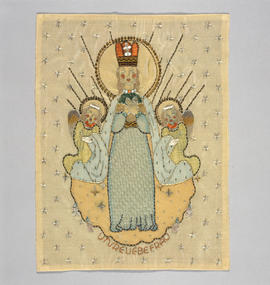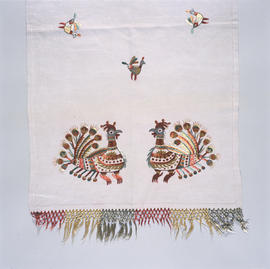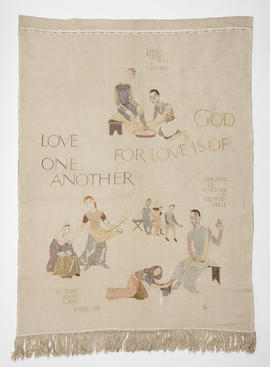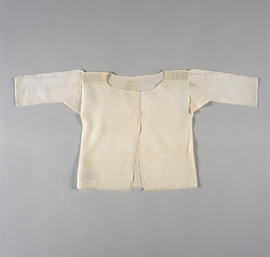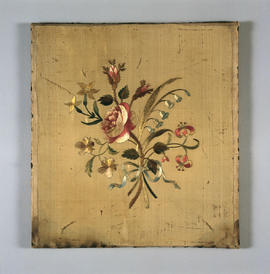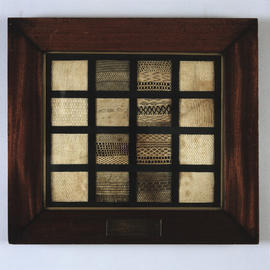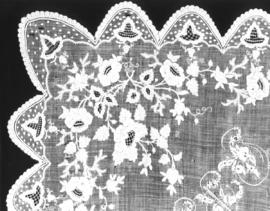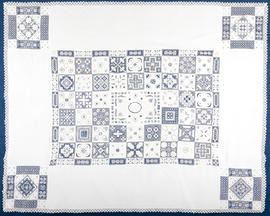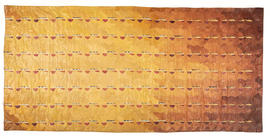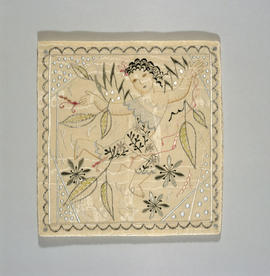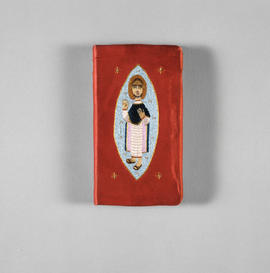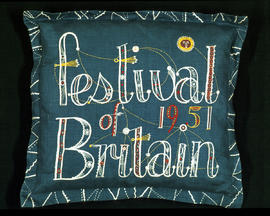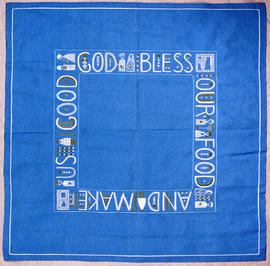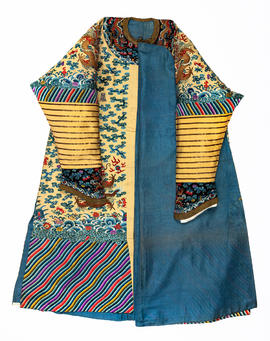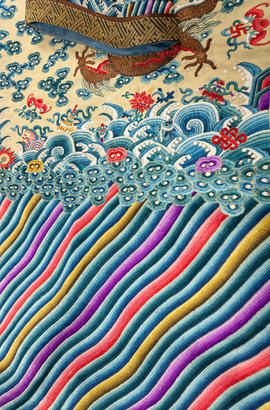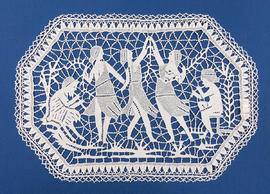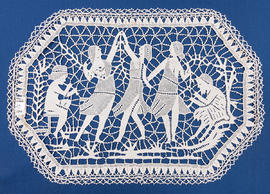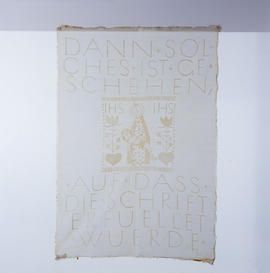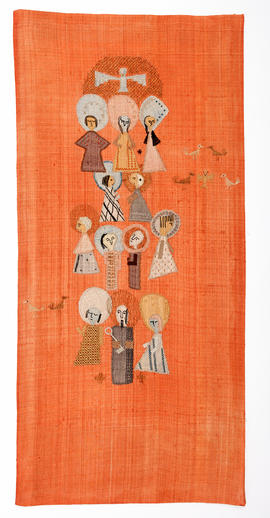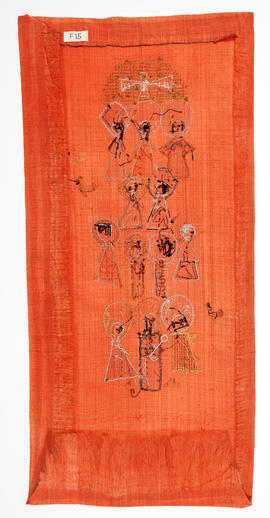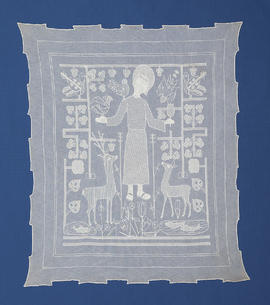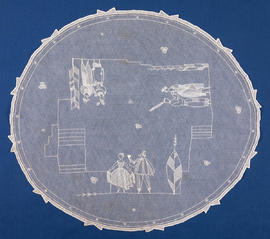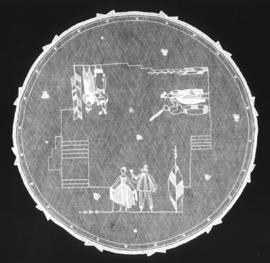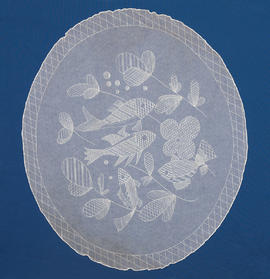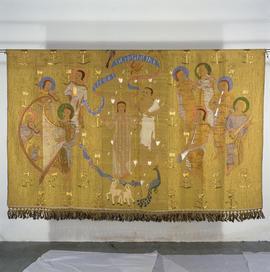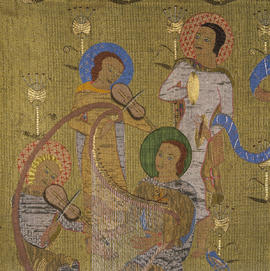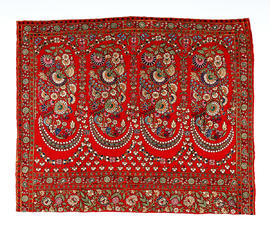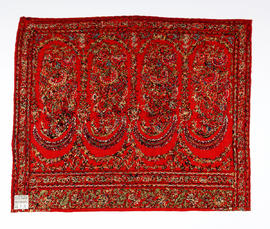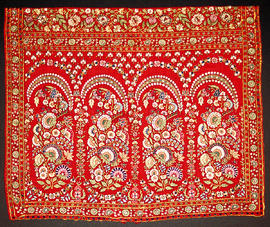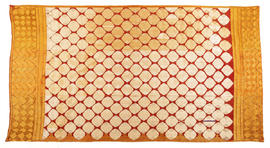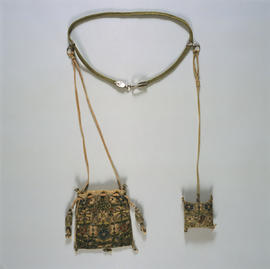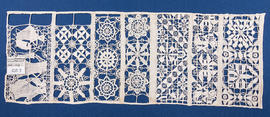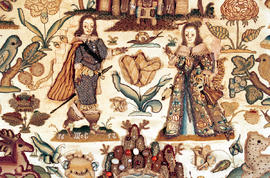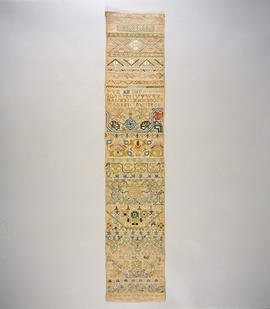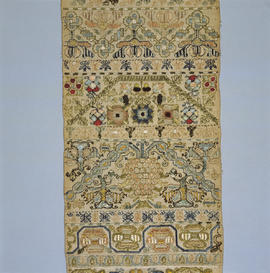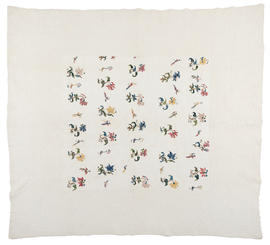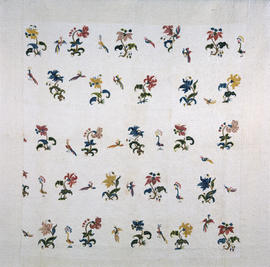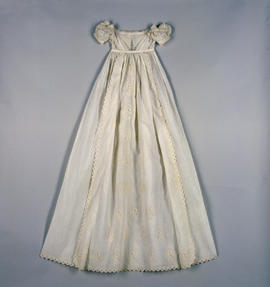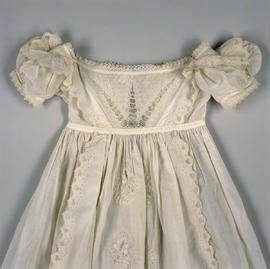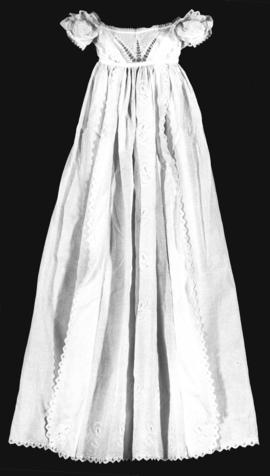Key Information
Reference code
Title
Date(s)
- 16th century to late 20th century (Creation)
Level of description
Collection
Extent
125 Items
Content and Structure
Scope and content
The collection consists of the surviving papers of the Needlework Development Scheme and over 100 examples of needlework. Of these examples, 28 are from Great Britain and 54 are examples of non-British work including examples from Greece, India, Norway, Sweden, Italy, Switzerland, Turkey and Bosnia. Items include ecclesiatical, domestic, costume, clothing and modern embroideries, tea cosies, funeral pall, clothing, lace work, wall hangings, samplers, linen work and cushion covers.
The surviving papers include a complete inventory of 1012 items that were part of the Needlework Development Scheme prior to its dispersal in 1961. This provides information on the original numbering scheme used for the needlework examples and also provides information on the provenance of each item, although this is not necessarily the creator of the item but the person from whom the item was received, as well as a description of the item itself. There is an inventory of the parts of the collection received by the Glasgow School of Art, insurance details concerning the collection and the correspondence of the Needlework Development Scheme, 1931-1941.
This material may contain sensitive information about individuals that is protected by the Data Protection Act. Until this material has been checked for sensitive information, it will not be available for researchers. Once this Data Protection work is complete the collection will be open for access, however any sensitive information will be closed and inaccessible for 75 years from the date of creation.
Appraisal, destruction and scheduling
This material has been appraised in line with Glasgow School of Art Archives and Collections standard procedures.
Accruals
System of arrangement
The collection is arranged into seven series:
- NDS GB: Examples of British needlework
- NDS F: Examples of foreign needlework
- NDS COR: Correspondence of the NDS
- NDS INV: NDS inventories
- NDS IMG: NDS images
- NDS PUB: NDS publications
- NDS REL: NDS related material
General Information
Name of creator
Administrative history
The Needlework Development Scheme (NDS) was a collaborative project between art and design education and industry. Originally established in Scotland in 1934, its aim was to encourage embroidery and to raise the standard of design in Britain.
Financed by J and P Coats, the thread manufacturers, the Scheme was organised by the four Scottish art schools, Aberdeen, Dundee, Edinburgh and Glasgow. Its collection of foreign and British embroidery was available to domestic science and training colleges, women's institutions and schools, as well as art schools. By 1939, the Scheme had acquired some 900 embroideries but the outbreak of WWII closed the Scheme and the collection was retained by the four original art schools.
Glasgow School of Art was instrumental in re-starting the Scheme late in 1944. Its aims were the same as its predecessor, but expanded its remit to include other arts schools in the United Kingdom where embroidery was taught.In the years following the WWII, the Scheme became centralised and staffed with a qualified embroidery expert, a secretary and several practitioners. The Scheme commissioned the British designer Mary Kessell to prepare designs to be interpreted by embroidery artists in Britain, as the best needlework examples in the collection were foreign. The result was a touring exhibition of work by the Bromley College in London.
The scheme was disbanded in 1961 when funding was withdrawn, although it was recognised that the NDS had achieved its aims. The NDS had amassed 3000 textile items by this time, which were divided and distributed around universities, art schools, organisations and museums including the National Museum of Scotland, the Embroideries Guild and the V&A.
Name of creator
Administrative history
In 1802, James Coats, snr, (1774-1857), a weaver from Paisley, Renfrewshire, Scotland, set up in business, laying the foundation of the business that was later to become J & P Coats Ltd, thread manufacturers, Paisley. James Coats senior was born in 1774, into a family of Paisley weavers. After serving his apprenticeship as a weaver, he spent six years in the army with the Ayrshire Fencibles, a cavalry regiment. He returned to weaving in 1796 on leaving the army and in 1802, shortly after his marriage, he went into business on his own. Seeing a market for Canton Crape, the majority of which was at that time imported from China, he set about trying to reproduce this material in his own factory. Canton Crape was made from silk, the manufacture of which had been introduced to Paisley in 1760 by Humphrey Fulton; hence both the raw material and the skilled labour were readily available. Another manufacturer, James Whyte, had also been trying to produce Canton Crape, with much the same degree of limited success as James Coats. He and Coats decided to combine their knowledge by entering into partnership, and were eventually successful in producing Canton Crape in such quantities as to virtually corner the market.
As his fortunes increased so James Coats began to look to the future. He built a house in Back Row, Ferguslie, Paisley, and became a sleeping partner in the Paisley firm of Ross & Duncan, a firm of thread twisters. At the same time he acquired knowledge of the business which would be useful to him in years to come since the production of Canton crepe requires yarn which has a particular twist. When his contract with Ross & Duncan expired in 1826, James Coats built a small mill at Ferguslie, and began producing his own thread, using a 12 horsepower engine. The mill at Ferguslie was the forerunner to the larger works which J & P Coats developed on this site. On his retirement in 1830, the management of the manufacturing department was passed to his partners and his son William, and the thread business was transferred to his sons James Coats, jnr, (1803-1845) and Peter Coats (1808-1890), the firm becoming known as J & P Coats. Shortly after its inception another son, Thomas Coats (1809-1883), entered the firm as a partner.
Each of the three brothers had knowledge of a different area of expertise: James in manufacturing, Peter in merchandising, and Thomas in engineering. The company expanded rapidly during the 1830s, both at home and overseas, and by 1840 three-quarters of their trade was with the USA. For twenty years the selling department of the American branch of the business was managed by Andrew Coats (1814-1900), a younger brother of James, Peter and Thomas. The high quality of Coats' thread made it extremely popular, to the extent that several companies produced inferior imitations, resulting in a number of legal cases In addition to the Paisley mills, J & P Coats built mills in the USA at Pawtucket, Rhode Island State, between 1870 and 1883. James Coats of Auchendrayne, Ayrshire, the son of Sir Peter Coats managed these mills. Production at Paisley continued apace, with new markets opening up at home and abroad. In some cases high customs duties were overcome by building mills abroad, so that in a short time J & P Coats had branches in Russia, Germany, Austria, Hungary and Spain.
In 1883, the firm became a private joint stock company of family shareholders and in 1890 the business was floated as a public company, with a capital of £5,750,000 and an average annual profit for the preceding seven years of £426,048. James Coats, jnr, remained unmarried, but a number of the sons of Peter and Thomas Coats entered the firm as partners, thus retaining the family interest in the company. One of the leading competitors of the Coats' firm was the firm of Clark & Co, another Paisley thread company, which had grown up through the same period as Coats. With the death of John Clark of Clark & Co in 1896, the way was opened for take-over. J & P Coats amalgamated with Clark & Co, its American associates and also with Brook of Meltham and Chadwick of Eagley Mills, Bolton, England, to form the enlarged firm of J & P Coats Ltd, with a market value of around £22 million, and approximately 25,000 shareholders. The company, with its headquarters in Glasgow, Scotland, had 17 production centres, 60 branch houses, 150 selling depots, and around 21,000 employees throughout the world, the UK workforce totalling around 11,000. One of the leading figures in the company at this time, was Otto Ernst Philippi, Foreign Sales Manager, whose selling policy has been regarded as one of the major keys to the firm's success.
The company continued trading as J & P Coats Ltd throughout the first half of the 20th century, expanding by acquiring controlling interests in several other textile companies. In 1960, following the takeover of Patons & Baldwins Ltd, the company became known as J & P Coats, Paton amp;& Baldwin Ltd. In 1965, they acquired a controlling interest in the Pasolds group, which included 'Ladybird' children's wear, 'Donbros' knitwear, and 'Chilprufe' garments. In 1967, they acquired both Dynacast Precision Engineering and Jaeger fashions. In June 1967, the company became known as Coats Patons Ltd. In 1967, Coats Patons Ltd amalgamated with Vantona Viyella to form Coats Viyella plc, a company registered in Uxbridge, Middlesex, England, which became Coats plc in 2001.
Between 1934-1939 the company sponsored the Needlework development in Scotland scheme, a collaboration between art and design education and industry. The scheme encouraged needlework and therefore also the sale of J & P Coats thread. This developed into the nation-wide Needlework Development Scheme managed by the The Central Agency Ltd of J & P Coats Ltd. Loan collections of historical and modern embroideries were developed with examples being purchased by, or donated to, the Scheme. These collections were then exhibited and loaned to schools in order to help teach and promote embroidery as an art form. In 1961, the company withdrew funding for the Scheme and it ceased to function. The collection of over 3000 textile items was broken up and disseminated between around 14 universities, colleges and museums in the UK.
Archival history
Custodial history
Deposited with the Glasgow School of Art in March 1962 and held in the School of Embroidery and Woven Textiles. Transferred to the care of The Glasgow School of Art Archives and Collections in 1999.
Physical Description and Conditions of Use
Conditions governing access
Glasgow School of Art Archives and Collections are open for research by appointment. For further details, please refer to our Access Policy @ https://gsaarchives.net/policies
Conditions governing reproduction
Application for permission to reproduce should be submitted to The Archives and Collections at The Glasgow School of Art.
Reproduction subject to usual conditions: educational use and condition of material.
For further details, please refer to our Reprographic Service Guide @ https://gsaarchives.net/policies
Language of material
- English
Script of material
Language and script notes
Physical Description
Finding aids
Related Material
Existence and location of originals
Existence and location of copies
Related materials
Notes area
Note
Collection Historical Note
The Needlework Development in Scotland scheme ran from 1934-1939 and was a collaboration between art and design education with industry, with its funding being received from J & P Coats, thread manufacturers of Paisley, Scotland, with the company's main office being located in Glasgow, Scotland. The aims of the Scheme were to encourage greater interest in needlework and to improve the standard of design, the scheme becoming a forerunner of the Needlework Development Scheme (NDS), 1944-1961, also funded by J & P Coats.
The NDS was led by the vision of Colin Martin, and based on the educational philosophies of the time. The Scheme's aim was to improve the standard of design and technique of embroidery by helping both teachers and students. Encouraging embroidery also meant that J & P Coats were creating a future market for their threads and at the scheme's height in the 1950s J & P Coats spent the current equivalent of £1m printing 15 million bulletins which were mostly issued free to school girls.
The NDS was managed from the Central Agency of J & P Coats in Wellington Street, Glasgow. Loan collections of historical and modern embroideries were developed with examples being purchased by, or donated to, the Scheme with some examples being purchased from the Glasgow School of Art. These collections were then exhibited and loaned to schools in order to help teach and promote embroidery as an art form.
In 1961, Coats Patons Ltd, formerly J & P Coats Ltd, withdrew funding for the Scheme and it ceased to function. The collection of over 3000 textile items was broken up and disseminated between around 14 universities, colleges and museums. In Scotland, NDS collections exist at The Royal Museum of Scotland, Paisley Museum, Dundee University, Edinburgh College of Art, Gray's School of Art at Aberdeen, and the Glasgow School of Art. The Glasgow School of Art was one of the places that received material from the NDS and Kath Whyte, the Head of School of Embroided and Woven Textiles at the time, was able to choose the items from the collection that she felt would be useful for use as teaching aids within her department.
Alternative identifier(s)
Keywords/Tags
Place access points
People and Organisations
- The Glasgow School of Art (Subject)
Genre access points
Status
Level of detail
Processing information
- Fonds level description compiled by David Powell, Hub Project Archivist, 11 November 2001. Updated by David Powell, Hub Project Archivist, 14 May 2002.
- Fonds level description added to CALM by Susannah Waters, GSA Archivist, 09 April 2008.
- Updated by Kimberly Sommerville, volunteer, 03 April 2009.
- Catalogue imported into Archon software and edited by Michelle Kaye, Archon Project Officer, May 2014.
- Catalogue exported from Archon and imported into AtoM during system migration, 2018-2019.
Language(s)
- English
Script(s)
Sources
Archivist's note
Finding Aid Authors: The Glasgow School of Art Archives and Collections.
Archivist's note
© Copyright 2014 GSA Archives. All rights reserved.



